Brightness and Contrast Ratio
For the brightness (luminance), contrast, and color accuracy tests, we depend on a hardware colorimeter and software to help calibrate the displays. We use a Monaco Optix XR (DTP-94) colorimeter and Monaco Optix XR Pro software, and we also test with ColorEyes Display Pro. Results in nearly every case have been better with Monaco Optix XR Pro, so we only report the ColorEyes Display Pro results on the monitor evaluation pages. We'll start with a look at the range of brightness and contrast at the default LCD settings while changing just the brightness level. (In some cases, it will be necessary to reduce the color levels if you want to achieve a more reasonable brightness setting of 100 or 120 nits.)
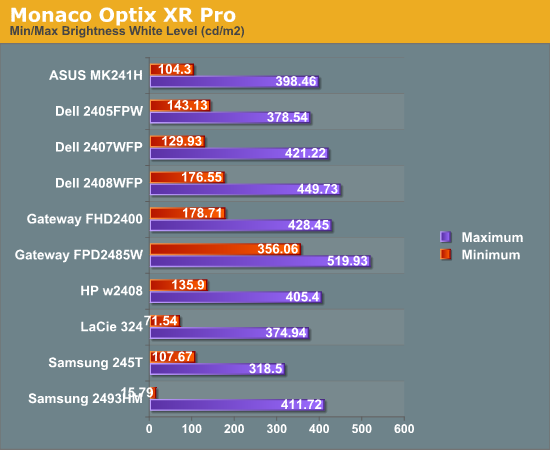
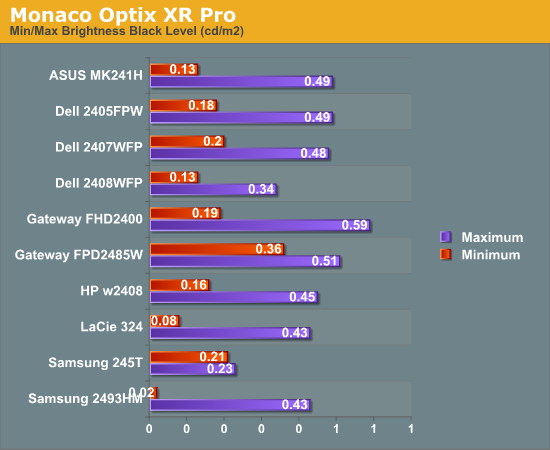
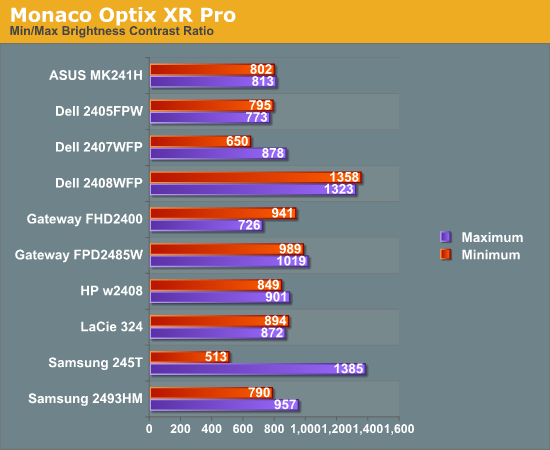
Nearly all of the LCDs have a maximum brightness level of around 400 nits, which is more than sufficient and is actually brighter than what most users prefer to use in an office environment. Minimum brightness without adjusting other settings is often above 100 nits, so it will be necessary to go in and adjust color levels as mentioned already. The Gateway FPD2485W is the prime example of this, where the default settings have a minimum brightness of 356 nits. Black levels are also reasonably consistent among the LCDs, with maximum and minimum black levels corresponding to the maximum and minimum white levels.
More important than the luminosity is the contrast ratio that is achievable at the various brightness settings. Here we begin to see some differences, with many of the LCDs following in the 800:1 ~ 900:1 range. The Dell 2408WFP and Samsung 245T stand out as having some of the highest contrast ratios, with the Dell taking the lead as it maintains the high contrast ratio even at low brightness settings. However, we should also mention that in practice the difference between 500:1 and 750:1 really isn't very significant for most users. It's only when you fall below 500:1 that colors really start to look washed out.
Color Gamut
We've already discussed color gamut of individual LCD evaluations, but it's a new addition to our LCD testing. This is something we wanted to add previously, but we lacked a good utility for generating the appropriate charts and data. We recently found out about Gamutvision, a utility developed by Imatest LLC. They were kind enough to provide us with a copy of their software, and it does exactly what we need. We compared the color profiles of all previously tested LCDs to the Adobe RGB 1998 color profile. Graphs of the individual gamut volumes are available on the evaluation pages. Below is a chart showing the percentage of the Adobe RGB 1998 gamut from the various displays.
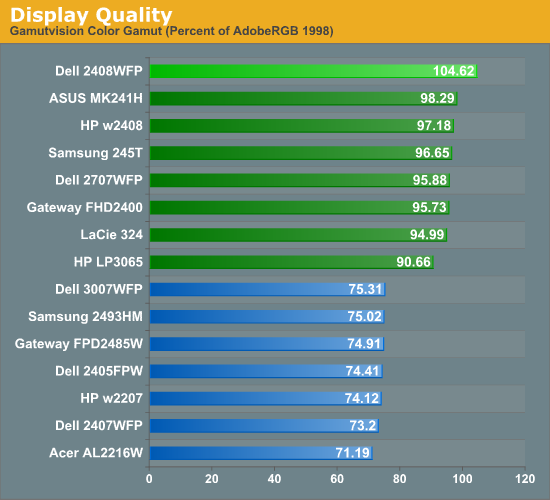
We basically end up with two tiers of quality in terms of color gamut. Filling the bottom tier are mostly older displays that have 82% NTSC color gamut backlighting. These may seem drastically inferior to the newer LCDs, but keep in mind that if you are just using the standard sRGB profile these LCDs look fine. It's only when you work in applications like Adobe Photoshop with its improved color space that you begin to notice a difference between the displays. Most of the newer displays now have ~95% Adobe RGB color gamuts, and the Dell 2408WFP actually surpasses the Adobe RGB 1998 color space. The only display in this round up that doesn't make it into the upper tier is the Samsung 2493HM.
Power Requirements
Another new test we decided to add with this roundup is a quick look at power requirements. Like the above tests, power requirements are checked at default LCD settings while varying the brightness setting. Also note that minimum power requirements are going to depend largely on how dim the backlight is at the minimum setting, so looking at the above charts it shouldn't be difficult to figure out that the Samsung 2493HM will require less power than the others when it's only putting out 16 lumens.
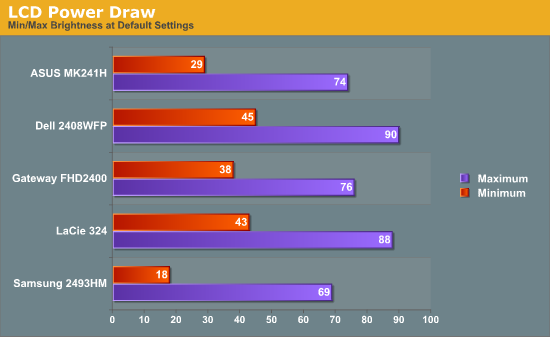
We've only begun collecting this data with this batch of LCDs, so we don't have any clear patterns established yet. However, it's interesting to note that the two S-PVA panels to seem to draw slightly more power than the three TN panels. At equivalent brightness settings, the differences in power draw are very small.










89 Comments
View All Comments
Bolas - Friday, July 31, 2009 - link
Anand,Any chance of a 30" monitor roundup for those of us wanting to buy an extreme HD monitor to go along with the new high end gaming computer we're buying around Christmas time?
I'm not sure which is best between the stuff currently on the market (or things coming out in the near future, say by Christmas). I've heard of:
Dell 3007WFP
Dell 3008WFP
HP LP3065
Gateway XHD3000
Samsung Synchmaster 305T
Apple Cinema 30"
Am I missing any 30" monitors currently available? Which is the best, regardless of price? Which is the best in terms of bang-for-the-buck? Which is "future-proof", with good connectivity? I plan to use it to play Starcraft II and Warcraft III and maybe some Everqeust.
I just turned 40, so as part of my mid-life crisis, I'm buying a high end gaming computer, probably a CyberPower Black Mamba or a Digital Storm of some kind, depending on how the stock market does.
Basically an overclocked Core i7 with three-way or quad SLI. My computer budget is $4000 to $6000, not including monitor price, and I can get a nicely configured Cyberpower for about $5400 last I checked. But what to use to display all that computer goodness? I figure to spend $1000 to $2000 on a 30" monitor, but which one?!?
Thanks!
-Bolas
szore - Tuesday, June 23, 2009 - link
I bought this for about $269 free tax and shipping and I love it for gaming.jpp - Monday, September 15, 2008 - link
Hi,First of all a big thank you for these reviews - they are top notch.
I'm currently trying to decise between the Samsung and the Dell. I'm not into gaming, so latency doesn't bother me. Nor for that matter do the plethora of inputs both provide - I'll just be using with the one DVI input at native resolution.
Living in PAL country, I would be delighted if either of these monitors do 50Hz FR. I doubt it very much, but thought it worth asking. I know that my large Samsung 405T wasn't specified at 50Hz, but it is able to do it natively nevertheless which makes for judder free PAL DVD and FTA TV program watching on the screen.
So, apart from this probably undefined/untested aspect, which would be the better choice, given as I say that I am not interested in gaming?
I bring this comparison up here as this review does not list the Samsung in its comparison table. The Dell was the editor's choice, but the Samsung was reviewed after this 24in line up, so I was wondering if it could be included somewhere in the ranking?
Thansk again for the tremendous effort that goes into the testing and reporting.
Phil.
jpp - Monday, September 15, 2008 - link
As I can't edit my previous post, just a correction wrt the timing of the 2 reviews.The Samsung review was done before the 24in panel review, yet it's not listed in this review. That seems a bit odd and I was wondering why that is the case?
billingsgate - Monday, May 26, 2008 - link
I can't find reviews anywhere of Eizo LCD monitors. Eizo has a great reputation, but that's all I seem to be able to go on. A salesman gave me a really good pitch for the Eizo FlexScan S2401W. It's a Samsung TN panel (he claims), but somehow being an Eizo it's much better for color quality than any Samsung in the price range. It seems to be a good candidate for balancing accurate color and minimum input lag. But I can't be sure, since I can't test it in the shop for any of those things, plus the shops where I live are all little cubby holes in computer centers, with minimum choice in each shop, so it's impossible to do any side-by-side comparisons between Eizo, Samsung, NEC, etc., since they're never together in the same place.Any thoughts on Eizo's (relatively) budget line of FlexScans?
silvajp - Sunday, May 25, 2008 - link
Today I bought a Samsung 2693HM for $600 - $50 rebate and I am blown away. It looks great - very bright and vibrant. I am wondering if it has the same low input lag as the 2493HM. The resolution is 1920x1200 so at 25.5" it's got bigger pixels which is just fine for my poor tired eyes.billingsgate - Thursday, May 15, 2008 - link
Can someone help me with a recommendation? After reading billions of reviews of monitors I am confused as hell? is there a "best compromise" LCD monitor for both color accuracy and least lag time?I am not a gamer. I am an animation professional, and I heavily use Wacom tablets for drawing, loose and freehand, with Photoshop, Flash, and various professional animation programs. I've always used a CRT monitor and never once have experienced any lag between my stylus movement and lines on screen. I do own a Compaq tablet PC, and when I draw on-screen, the lag is perceptible enough to make the drawing very unnatural and inhibited. I just can't draw freehand that way.
As my beloved, expensive flat screen Samsung CRT monitor is now dying after 7 years of heavy use, I'm in the market for an LCD. In my business I need both excellent color accuracy and zero or minimal lag time for stylus input. Where I live (Hong Kong) there isn't a single shop that would ever allow me to test such a setup, so it's a lottery for me. Plus, their in-store demonstrations for color "accuracy" are geared for Asian tastes, which is heavy HEAVY on oversaturated red (while westerners prefer oversaturated green).
After poring through all the reviews, particularly on this site, I can't even narrow down the choices to 4 or 5 candidates. The Dell 2408 looks amazing except for lag time. The Samsung XL20 (not widescreen, but I don't really care) looks great for color and no lag time, but it has a noisy fan (irritating!) and is a bit smaller than I want.
Can someone seriously help me to narrow the potential choices for something that has good or great color and minimal input lag? I won't ever use it for gaming or for TV or video viewing.
hjkelly - Thursday, May 15, 2008 - link
I'm in a similar spot - into editing photos and watching movies. I was almost set on the Dell 2408, but then I found out it has about four frames of lag, which wouldn't be fun for movies (or drawing with a Wacom tablet, I'm sure). I've finally settled on DoubleSight's DS-263N. If you want a quick summary, it's like an Apple Cinema display, but 26" and with a polarizer to get rid of the white haze at wider angles. It's also very fast, less than one frame's delay, I believe. It's around $700, but the catch is that it's hard to find in stock, so you'll have to be on your toes to get one. But isn't that just a sign of quality, really? =)JarredWalton - Friday, May 16, 2008 - link
Surely you know someone over there that can let you borrow an LCD to test out? Honestly, I don't think you'll experience problems with input lag - we're talking about 50ms or so relative to a CRT, so 1/20 of a second. What you've noticed on a tablet PC probably has a lot more to do with the lack of processing power and other differences. All you really need to do is find someone with an S-PVA 24" LCD and you can see if you notice lag. I can game fine on the 2408WFP - the lag is just barely perceptible at times, but not enough to cause me problems. But I'm not a competitive gamer.As for DoubleSight, their 26" LCD is about to be phased out apparently - I asked them for a review sample and they said it was at EOL. It may become even more difficult to find in stock shortly.
Anyway, I hear good things about a few MVA panels (that I haven't ever seen let alone tested), or if money isn't a serious concern just pick up something like the HP LP3065. For professional use, I have a hard time finding anything I would prefer to a nice S-IPS 30" LCD. And the 2560x1600 gaming resolution is nice as well.
billingsgate - Friday, May 16, 2008 - link
Actually, I don't know anyone with an LCD screen to borrow, other than my son's cheap one which is fine for gaming but not even close to being color accurate, so not exactly a good example. I can tell you that I tried a Wacom Cintiq tablet, which is essentially an LCD screen you can draw on. It was connected to a G5 Mac, so no lack of processing power. The lag on that was a fraction of a fraction of a second. But I kept finding my hand slowing down to let the line catch up to the stylus, which sucked all the spontaneity out of my drawing. In other words, for a "sensitive artist", even a small lag is noticeable. With the Cintiq I attribute it to the signal having to travel round trip on a USB connection. But I am now quite concerned about buying the wrong LCD and being stuck with it. This isn't the USA. Once you buy something and leave the shop, there is no such thing as returning it.So, to repeat my question: can you or someone help to recommend a shortlist of monitors that are both good to great for color accuracy, and minimal for input lag?